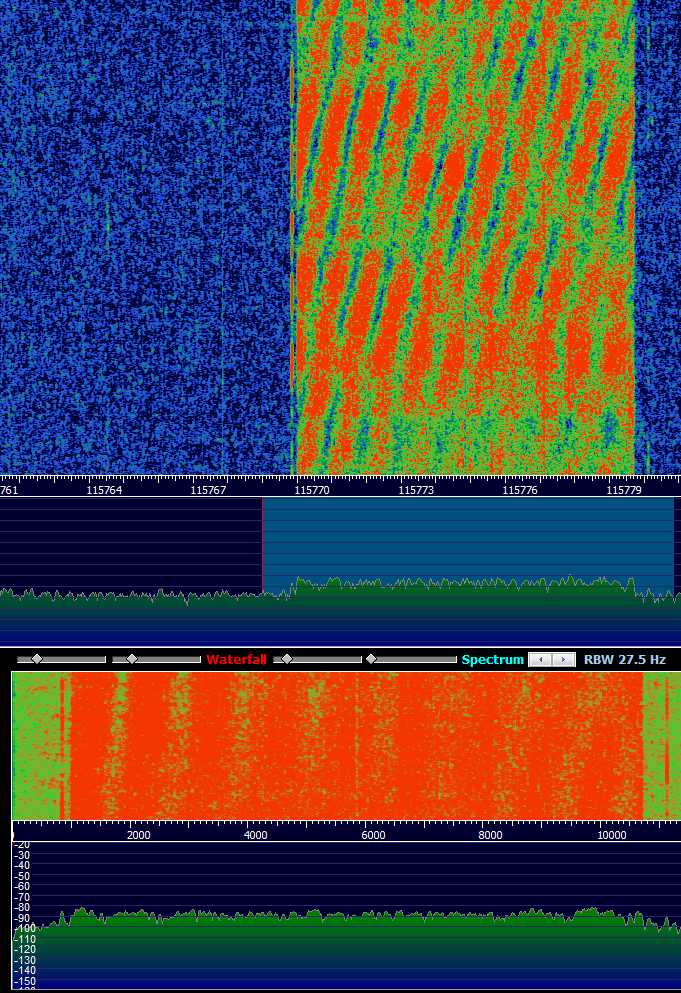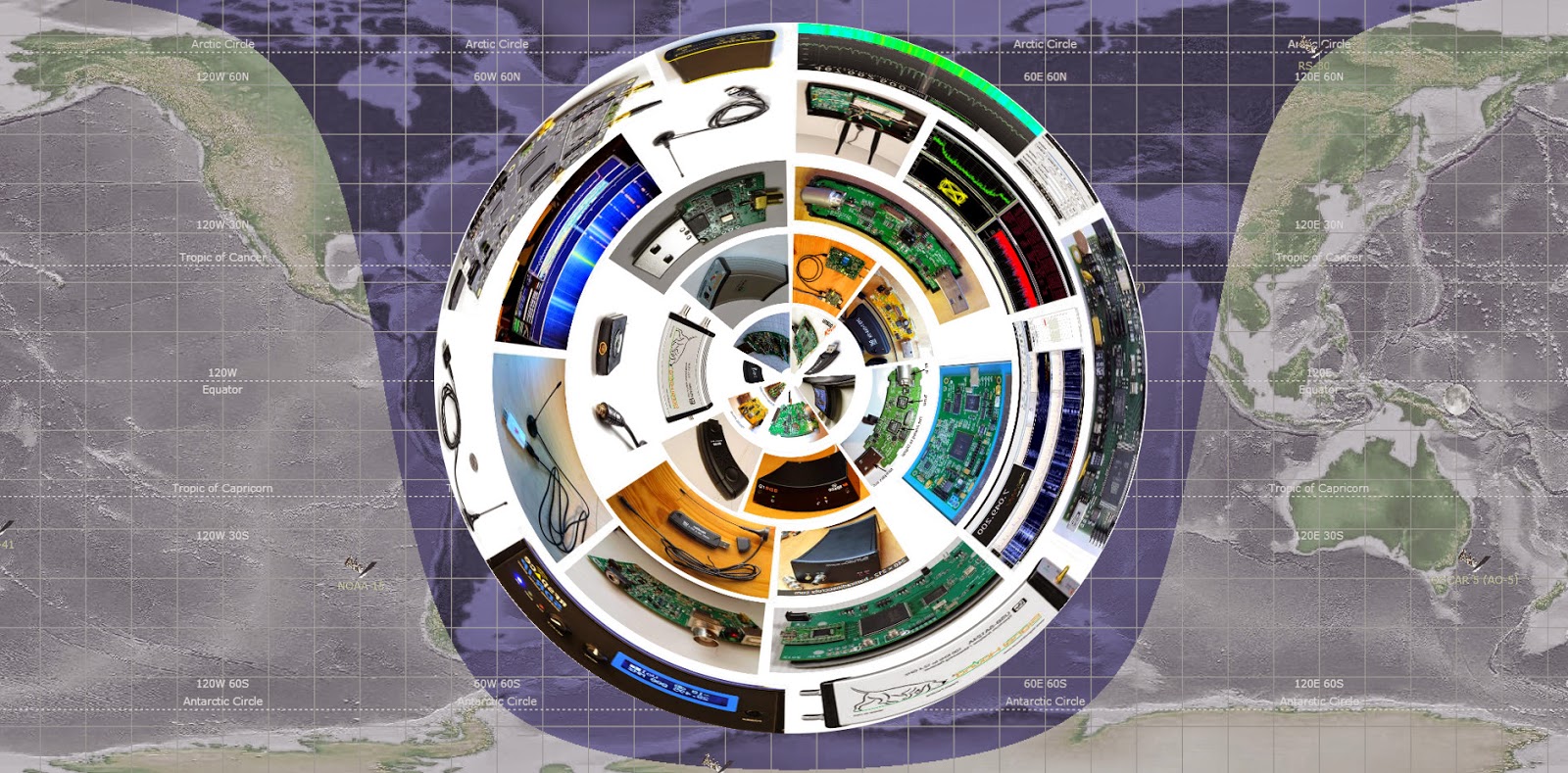The versatility of the Software Defined Radio doesn't seem to have boundaries. While exploring the HF bands, I tried to decode the occasionally received signal from Vatican Radio (http://en.radiovaticana.va/), which as of this writing was the only station I could identify as sometimes transmitting in DRM.
Ad
Friday, December 26, 2014
Listening to Digital Radio Mondiale
The versatility of the Software Defined Radio doesn't seem to have boundaries. While exploring the HF bands, I tried to decode the occasionally received signal from Vatican Radio (http://en.radiovaticana.va/), which as of this writing was the only station I could identify as sometimes transmitting in DRM.
Wednesday, December 3, 2014
SDR - going higher in the wavelengths
While a 22 - 1400 MHz band coverage is pretty cool (given the price of the hardware), there is still more beyond (and below) these bands. In particular LF, MF and HF bands are interesting for a number of reasons:
Saturday, October 18, 2014
Again with the SDR (Software Defined Radio) craze
After I bought my first RTL-SDR dongle (regarding which I made this post covering APT satellite (weather) image reception: http://creationfactory.blogspot.pt/2013/03/receiving-weather-satellite-images-with.html ), it's been sitting on the bench without much use. More recently I found extra stuff that could be interesting to take a look at, such as ADS-B reception (decoding commercial aircraft transponder signals) and less earthly things such as a doing some radio-astronomy, which includes for example trying to detect the 1420 MHz hydrogen line RF signal emitted from within our galaxy (it's a very exact frequency almost as accurate as our atomic clocks).
http://www.rtl-sdr.com/low-cost-hydrogen-line-telescope-using-rtl-sdr/
Tuesday, August 26, 2014
Optical test
Saturday, August 23, 2014
Traveling
Satisfaction with the 500mm reflex lens increases as I explore its potential in different situations. This time I took a number of shots holding it by hand during an afternoon next to the Lisbon international airport main runway. It was quite a challenge because of the moving targets, the lens being a pain to focus, and the fact that the camera was being held by hand. But the results seem to tell the rest...
Wednesday, August 20, 2014
World Photography Day
Coincidentally, after having purchased an exotic lens for my camera and some days of wait for the F-Mount adapter, yesterday during the World Photography Day, I finally managed to test the lens. Aware of the shortcomings of this lens, still I was very pleased with the results, which I must say, open doors to different types of photographic work.
The lens is a Samyang 500mm f/6.3 mirror prime:
Saturday, June 14, 2014
Reflashing a quad ESC to BLHELI firmware in an attempt to solve pancake motor cogging issues
Ever since I've switched motors and ESC's on my "primary" quadcopter, I have been running on problems keeping it reliable. Every now and then it would crash, once because of a motor connection that got broken, and other times in a unpredictable manner without a cause that I could identify.
Saturday, May 31, 2014
Teardown of a laser printer
In this age of mass consumption and programmed obsolescence, it is not surprising that a few years after you shell out money for a printer, the availability of its consumables starts to decrease, followed by an increase of the associated price.
Thursday, May 29, 2014
Gimbal finally onboard
After a long wait and a hassle with a chinese seller, finally I could but together the gimbal, flash the board with Brugi (Martinez) and do some tuning and testing.
While a first flight have not yet been done, manual handling with rough attitude change movements shows that the gimbal seems to respond pretty well and no vibration could be perceived in the video at 1080p.
While a first flight have not yet been done, manual handling with rough attitude change movements shows that the gimbal seems to respond pretty well and no vibration could be perceived in the video at 1080p.
Wednesday, April 2, 2014
Custom made BEC
BEC's, which is short for Battery Eliminator Circuit is a fancy RC hobby term for a DC-DC converter that steps down the voltage to a given value used for example by servos and control electronics such as radio gear and flight controllers.
In the market there are two main types, most of which convert from a higher voltage to 5-6 Volts DC. These can either be of the linear type, or switching mode. The first is the simplest, where a simple linear regulator is used to drop the voltage to a constant value at the output. These tend to be very low noise steady sources of voltage, but have the disadvantage of being quite inefficient, getting worse the higher the input-output voltage differential. A considerable amount of energy is wasted in the form of heat.
In the market there are two main types, most of which convert from a higher voltage to 5-6 Volts DC. These can either be of the linear type, or switching mode. The first is the simplest, where a simple linear regulator is used to drop the voltage to a constant value at the output. These tend to be very low noise steady sources of voltage, but have the disadvantage of being quite inefficient, getting worse the higher the input-output voltage differential. A considerable amount of energy is wasted in the form of heat.
Sunday, March 30, 2014
2nd quadcopter practically RTF...
Other than having the recently ordered flight control board (Multiwii SE) mounted and configured, everything else was completed today with the addition of the custom made landing gear:
Tuesday, March 25, 2014
Brushless gimbal almost complete
With the arrival of the Mobius action camera, which is a Full HD (1920x1080 @ 30 Hz) little animal (very nice video quality for the price), my aerial filming addition to my #1 quadcopter is almost complete. The only missing element is the gimbal controller board, which I have ordered through ebay, but my mistake (or not) the seller have sent the MPU6050 instead (which I had at the same time ordered from a different seller). Result: I have two MPU6050 gimbal sensors and no gimbal controller. As such a dispute is being solved, and the seller decided to (supposedly) ship me the controller board. Otherwise I will escalate to ebay, get refunded, and the seller downgraded (or banned, who knows..).
Tuesday, March 18, 2014
Improved quadcopter - more "avionics" and increased run time
In the several weeks that followed a crash caused by an ESC failure, plenty of work have taken place (some of which documented here). Several things have been done since:
- Replacement of the ESCs with a 30 Amp quad ESC;
- Upgrade of the flight controller firmware;
- Building and programming the PPM Sum encoder;
- Building a BEC/filter with 12 V and 5 V outputs;
- Adding landing gear;
- Adding voltage and current sensor;
- OSD firmware upgrade;
- Change of LiPO battery from 11.1 V (3S) to 14.8 V (4S);
Monday, March 17, 2014
Induction Stove
Some days ago my father asked me to check if I could repair this single element induction stove. I disassembled the device to inspect its inner workings. I was a bit curious because I have never taken apart this kind of apparatus.
Monday, March 3, 2014
Smoke test after a lot of changes
It's always a stressful moment when after many changes something is put to the test. This was the case, taking into account that since the last flight there was a replacement of all ESCs, upgrade to Arducopter MPNG 3.0.1 R4, installation of PPM Sum module, addition of voltage and current measurement, and use of a higher system voltage (4S instead of 3S LiPo).
Sunday, March 2, 2014
Busy quadcopter setup weekend
With the arrival of some of the parts I have been waiting for, more work accumulated with the finishing of my 2nd quadcopter. The parts were the landing gear and the quadruple ESC:
The landing gear arrived with all the necessary parts as expected, including the lower crossing bar and the foam rods. The bar and other rods are all made of carbon fiber. The 4 support rings (for attaching to the frame) all had a rubber ring which helps to further dampen the vibration to additional items such as a camera:
Thursday, February 27, 2014
Reflash the ESCs
Multicopters require a tight control loop for all the motors as part of their ability to perform stable flight. A basic requirement for an efficient closed loop PID system is that it has a high enough sample rate and fast response to error input when the knowledge about the system is minimal. Until recently most ESCs were designed for airplane and helicopter applications, where gradual response to input is desirable for saving the gears against abrupt torque variations. In quadcopters, direct driving of the propeller is normally the case (and as such mechanical wear is not much of an issue), and as explained, quick response to throttle input is required for good PID response.
Wednesday, February 26, 2014
One step closer...
A tray for the battery was added. Keeping simplicity and light weight in mind, I have built this tray based on an aluminium foil and four threaded rods. Four plastic straws (from kids balloons) served as spacers between the tray and the quadcopter chassis. The height of the tray was set based on the Turnigy 5000 mAh 3S battery I will be using:
Tuesday, February 25, 2014
New quadcopter taking shape
One evening at a time and this new drone begins to get closer to completion. Motors installed and thread locked. Power distribution board and flight controller also installed. The next step will be to install the reprogrammed ESCs (I will check for SimonK updates), wire things together, and make a support for the battery (I'm thinking about using some folded threaded rods as a kind of cage for holding it, or something similar).
Sunday, February 23, 2014
New drone, old parts
With all the changes and upgrades I performed on my current quadcopter, I realized I had about enough spare parts to build another one. The only missing thing was the frame, but this is where the fun part goes. With this I had the opportunity to build a frame from scratch after buying 1m of aluminum rod, and a 1.5 mm sheet of the same material. This resulted in a 177 gr frame, which is not too bad.
Sunday, January 12, 2014
Ground Control Station
With the model aircraft hobby scaling beyond line of sight, control equipment also grows more complex and sophisticated these days. To the point where we no longer designate it of transmitter, but refer to it as "Ground Control Station".
Subscribe to:
Posts (Atom)



